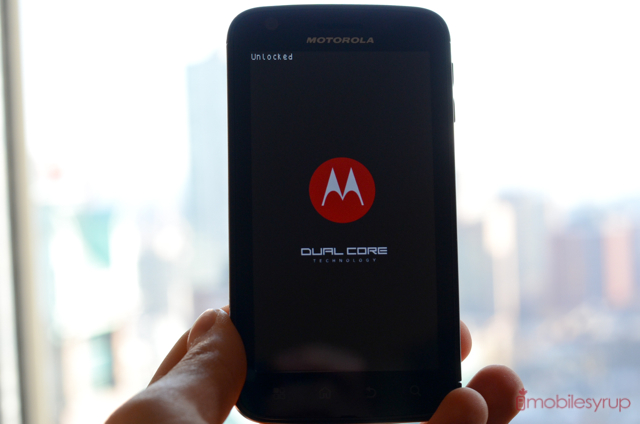 It’s been nearly a year since the Motorola Atrix was announced at CES, and ten months since it was released in Canada. At the time it was running Motoblur on top of Android 2.2 Froyo, and while the hardware blew us away, the software definitely did not.
It’s been nearly a year since the Motorola Atrix was announced at CES, and ten months since it was released in Canada. At the time it was running Motoblur on top of Android 2.2 Froyo, and while the hardware blew us away, the software definitely did not.
Since then, three things have happened: 1) It received an upgrade to Gingerbread, which completely overhauled its software and gave it a huge performance boost. 2) Its bootloader was unlocked, allowing for custom ROMs, kernels and recoveries. 3) It’s been surpassed time and time again by its competitors, including some more recent Motorola devices.
But to its credit the Atrix, with its 4″ qHD display, 1Ghz dual-core Tegra 2 processor, 1GB RAM, 16GB internal storage and huge 1930mAh battery, has survived the onslaught of time pretty well.
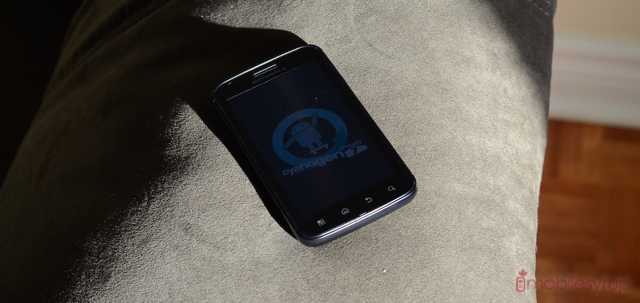 First, let’s go over what has held up well. Since its launch every major ARM-based manufacturer, from Qualcomm to Texas Instruments to Samsung, has released a dual-core solution. And even NVIDIA’s own Tegra 2, with which the Atrix was the first to launch in phone form, is about to be supplanted by the quad-core Tegra 3. But dual-core 1Ghz still feels fast, and using the Atrix now is not a significant step down from the latest Snapdragon or OMAP.
First, let’s go over what has held up well. Since its launch every major ARM-based manufacturer, from Qualcomm to Texas Instruments to Samsung, has released a dual-core solution. And even NVIDIA’s own Tegra 2, with which the Atrix was the first to launch in phone form, is about to be supplanted by the quad-core Tegra 3. But dual-core 1Ghz still feels fast, and using the Atrix now is not a significant step down from the latest Snapdragon or OMAP.
This is aided by the fact that the Atrix included 1GB of RAM when the rest of the industry was pumping out phones with half that number. Multitasking still feels effortless and fluid. The included 16GB storage has also aged well: there isn’t a single Android phone on the market that ships with more than that.
The Atrix’s speed practically doubled overnight when Bell released the Gingerbread update in August. In truth, though, I installed Android 2.3 long before that, when enterprising hackers unlocked the device’s bootloader and discovered, hidden in plain sight on Motorola’s servers, early builds of the eventual upgrade. Not only was it a big aesthetic change — they did away with most of Froyo’s ugly, blocky design choices — but Motorola injected some magic into the kernel, as the device just flew.
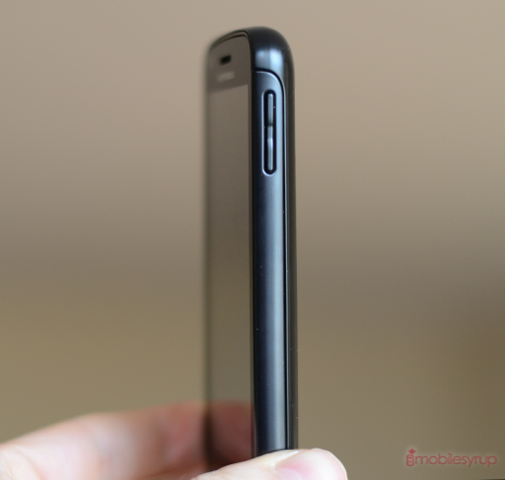
Then came CyanogenMOD7. From being one of the most locked-down devices on the market emerged a piece of versatile hardware that now has a vibrant development community. CM7 changed the way I used the Atrix, giving it the same enormous feature set as the other 50+ handsets supported by the custom ROM.
And, whether you’re running a custom stock-based ROM or CM7, various kernel improvements have helped developers push the capabilities of the 1930mAh battery to unbelievable levels. The Atrix is still, by far, the longest-lasting Android device I’ve ever used. I can easily get two days of use from it.

Physically, the Atrix hasn’t aged so well. Stout even at its release, it feels practically bloated now. We know now the extra girth was needed to accomodate the huge battery, but its plastic body and flimsy battery cover have since been condemned to the “2010 design faux pas” category.
I still think that its 4″ screen size makes for a very comfortable experience — far better than the 4.3″ – 4.6″ variety. The qHD screen is a slim 16:9 ratio, so the Atrix is easy to hold between two fingers. The quality of the screen, however, leaves a LOT to be desired. This is the area in which Motorola has fallen the farthest behind — even on their latest handset — and after using the Galaxy Nexus and Optimus LTE extensively, the PenTile-inclined Atrix looks practically terrible. With inaccurate colours and poor viewing angles, not to mention practically unreadable text at its furthest zoom, we’re happy these days are behind us.
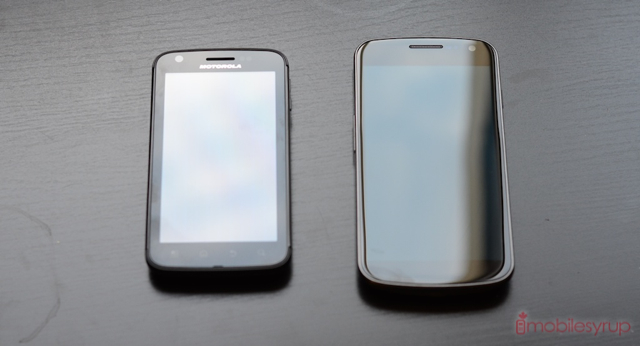 Moving on, the Atrix is a great phone. No, I mean an actual phone: sound quality from the earpiece and speaker is still best-in-class. Fundamentally, this makes it a mean business phone. It’s got all those great Motorola business features such as built-in certificates and extensive vendor VPN support. And remember, it has that unique fingerprint scanner that has yet to make it, for better or worse, to any other smartphone.
Moving on, the Atrix is a great phone. No, I mean an actual phone: sound quality from the earpiece and speaker is still best-in-class. Fundamentally, this makes it a mean business phone. It’s got all those great Motorola business features such as built-in certificates and extensive vendor VPN support. And remember, it has that unique fingerprint scanner that has yet to make it, for better or worse, to any other smartphone.
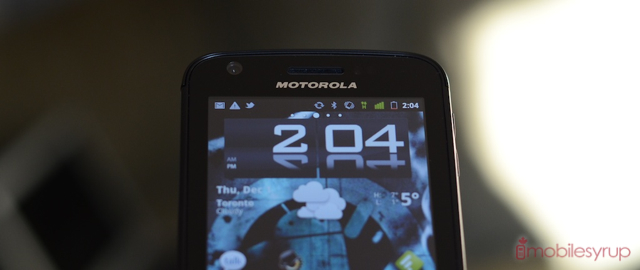 The camera on the Atrix still sucks. That won’t change, and as other manufacturers make improvements to their optics the Atrix will begin looking even worse in comparison. Focus is slow, low-light quality atrocious and photos overall lack detail and colour.
The camera on the Atrix still sucks. That won’t change, and as other manufacturers make improvements to their optics the Atrix will begin looking even worse in comparison. Focus is slow, low-light quality atrocious and photos overall lack detail and colour.
But with the Gingerbread update came a nice bonus: 1080p video recording. Though it took a third-party app to actually capture video at such a high resolution, today we have a phone that captures decent true HD at 24fps.
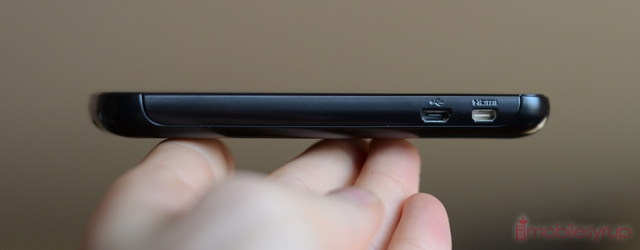 The Atrix was one of the first Android handsets to come with an HDMI-out port, capable of transmitting a 1080p signal to your home theatre system. And while it came with a Webtop and HDMI dock, sold separately, its built-in HDMI mirroring feature was enough for most people.
The Atrix was one of the first Android handsets to come with an HDMI-out port, capable of transmitting a 1080p signal to your home theatre system. And while it came with a Webtop and HDMI dock, sold separately, its built-in HDMI mirroring feature was enough for most people.
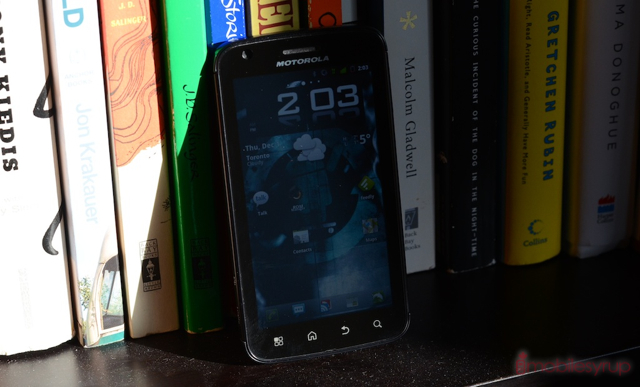 The Atrix, nearly a year later, is still going strong. Countless Android handsets have been released since March, boasting improved internal specs, sharper screens and better build quality. But then, as now, Bell’s first superphone still retains many of the qualities that made it such a compelling device to begin with.
The Atrix, nearly a year later, is still going strong. Countless Android handsets have been released since March, boasting improved internal specs, sharper screens and better build quality. But then, as now, Bell’s first superphone still retains many of the qualities that made it such a compelling device to begin with.
MobileSyrup may earn a commission from purchases made via our links, which helps fund the journalism we provide free on our website. These links do not influence our editorial content. Support us here.


